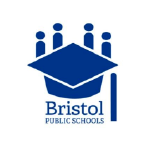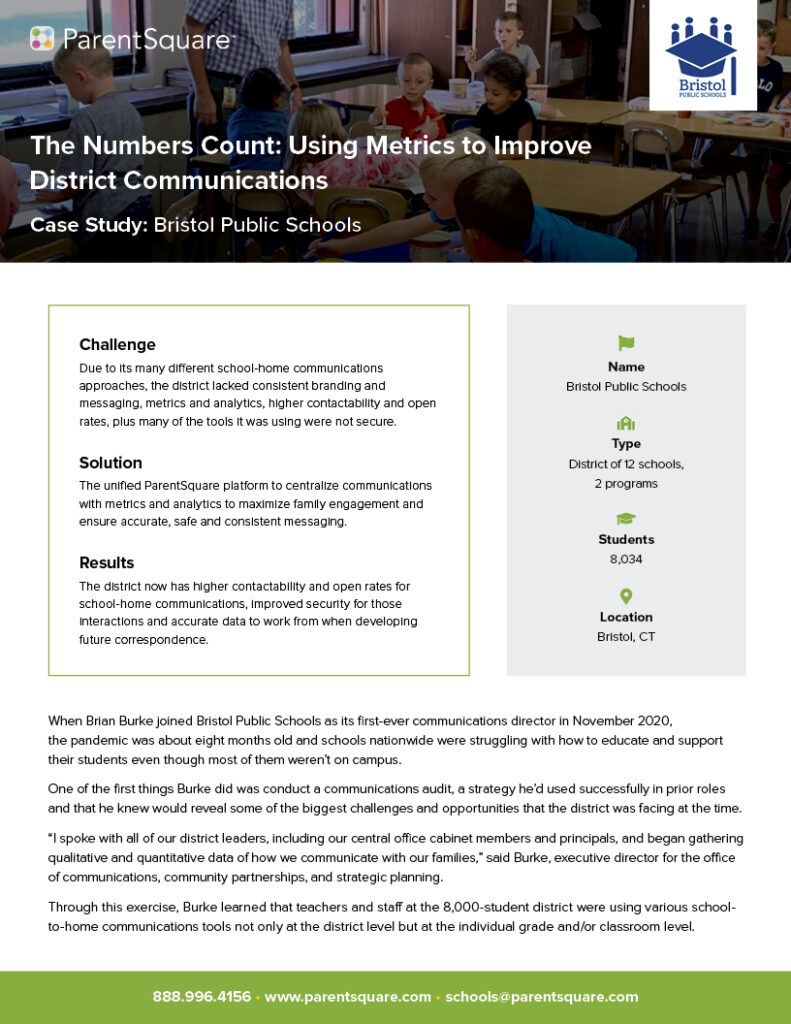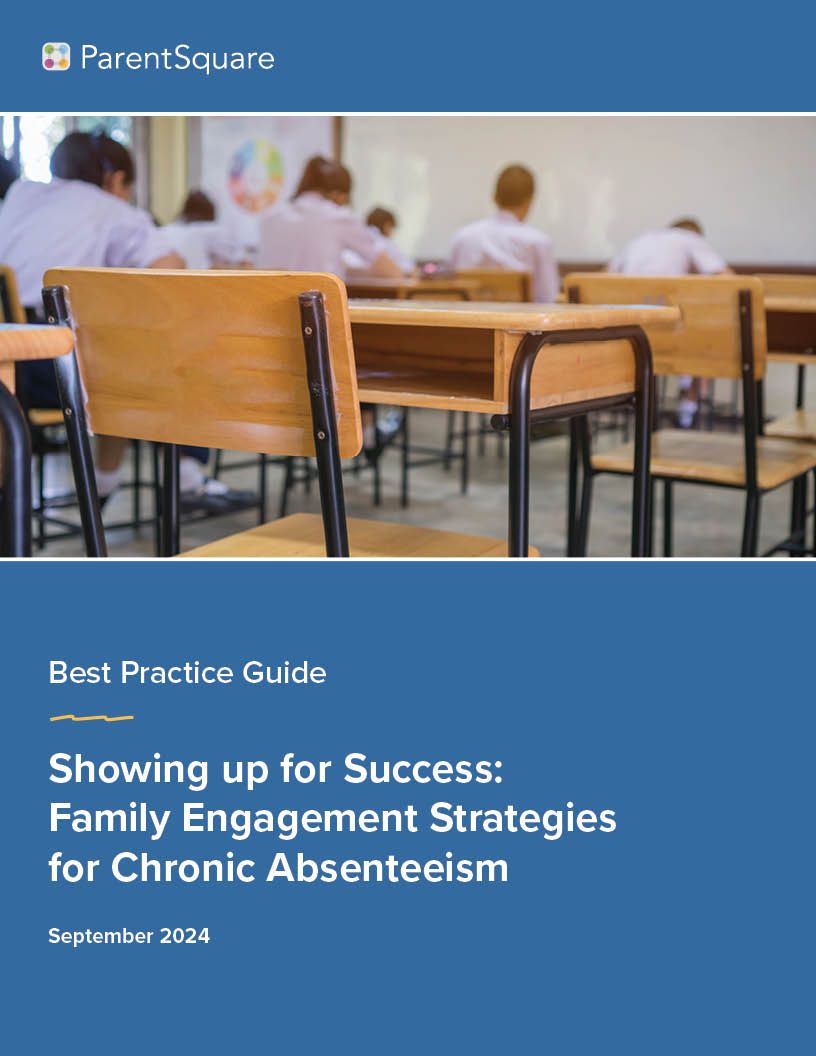
The Numbers Count: Using Metrics to Improve District Communications
Case Study: Bristol Public Schools (CT)
Challenge
Due to its many different school-home communications approaches, the district lacked consistent branding and messaging, metrics and analytics, higher contactability and open rates, plus many of the tools it was using were not secure.
Solution
The unified ParentSquare platform to centralize communications with metrics and analytics to maximize family engagement and ensure accurate, safe and consistent messaging.
Results
The district now has higher contactability and open rates for school-home communications, improved security for those interactions and accurate data to work from when developing future correspondence.
When Brian Burke joined Bristol Public Schools as its first-ever communications director in November 2020, the pandemic was about eight months old and schools nationwide were struggling with how to educate and support their students even though most of them weren’t on campus.
One of the first things Burke did was conduct a communications audit, a strategy he’d used successfully in prior roles and that he knew would reveal some of the biggest challenges and opportunities that the district was facing at the time.
“I spoke with all of our district leaders, including our central office cabinet members and principals, and began gathering qualitative and quantitative data of how we communicate with our families,” said Burke, executive director for the office of communications, community partnerships, and strategic planning.
Name
Bristol Public Schools
Location
Bristol, CT
Students
8,034
Type
District of 12 schools,
2 programs
Through this exercise, Burke learned that teachers and staff at the 8,000-student district were using various school-to-home communications tools not only at the district level but at the individual grade and/or classroom level.
This approach was creating two key problems: the district had no consistent branding or messaging and many of the platforms it was using were not secure. “There was no districtwide oversight or management of our communications,” said Burke.
A Centralized Voice
The district was also dealing with data gaps, particularly when it came to school-to-school interactions. A family with multiple children in the school district at one time, for example, would receive a myriad of different types of communications for those students. Contact data was outdated and this made it difficult for school administrators and teachers to reach some families.
Bristol Public Schools also wanted to present a unified voice for its families — something it couldn’t get from its disparate systems.
“One of my main concerns was that we did not have a centralized medium for distributing information, where families would know that the information they were receiving was 100% accurate and reliable,” Burke explained. “Information and content were being pieced together across 14 different schools and various programs. We needed a singular, centralized voice.”
The Right Solution
In search of a technology platform that could give Bristol Public Schools the centralized voice it needed, Burke began researching various options on the market. With a diverse student body that speaks 35 different languages, he knew that a communications platform with translation abilities would ensure higher contactability rates.
After exploring its options, the district decided to implement ParentSquare for all school-home communications. Some of the safe and secure platform’s key selling points included its centralized information repository; the fact that it offers text, email and mobile app communications options; and how easy it is to keep student contact data up-to-date — a feature that drives those consistently high contactability rates.
“When we launched ParentSquare in our district, our connection rate with our families was about 99% because we had a lot of people update their contact information from outdated data from our student information system,” said Burke. “That’s been a great way to update contact information for everyone.”
Burke also liked ParentSquare’s data security features, which are particularly useful when sending videos or photos that require signed waivers on an annual basis. The platform also offers insightful analytics that Burke and other staff members use to review which posts are performing better than others for specific schools.
“We can figure out why the posts may not be working well and then show our principals or teachers how to tweak those posts to attract more engagement,” said Burke. “This helps me get more engaged with what’s happening on a day-to-day basis in our classrooms from a communications perspective.”
In fact, Burke said that without ParentSquare, he would have few (if any) insights into those communications. The platform has also helped the district present a unified front on social media platforms. “My role is very district-level driven,” he explained. “The ParentSquare platform is a great way for me to see what we are communicating at the school and classroom levels and to monitor any public interactions.”
Data is the New Fuel for School Districts
Before it implemented ParentSquare, Bristol Public Schools didn’t really know whether anyone was reading the emails that it was sending out. When it was sending out communication about Covid, for example, it just presumed that people were opening and reading those messages — but it didn’t have the data to back up those assumptions.
The longer the pandemic dragged on, the lower the odds that someone would read related messages. “Many of our families became normalized to pandemic-related communications, as COVID-19 became a part of our daily lives,” said Burke. “It reached the point where if we were sending out anything related to COVID-19, it had a much lower open rate in comparison to when the pandemic began because people became used to it.”
To reverse this trend, the district carefully assessed how it could package that and other information and its messaging so people would start opening the correspondence. It looked at subject lines, keywords and other metrics, and experimented with those in the ParentSquare platform.
Burke also launched a digital district newsletter that covered a range of topics and began seeing open rates of 45-50%. “With ParentSquare, I can see what our messaging is, what resonates and what does not, and what our parents truly care about. I do not know how districts operate without these types of metrics,” said Burke, who sees the school-home platform as an effective data gathering and aggregation tool for modern school districts.
“Today’s districts have to be ‘real-time’ because with all of the technology at their disposal, people can find information before we even have a chance to send it out,” Burke continued. “Knowing what that information is and how we are going to quickly communicate it has always been important, but it’s especially critical now in the times we are living in.”
“When we launched ParentSquare in our district, our connection rate with our families was about 99% because we had a lot of people update their contact information from outdated data from our student information system. That’s been a great way to update contact information for everyone.”

Brian Burke
Executive Director of Communications, Community Partnerships, and Strategic Planning

Share This Case Study
Enter your email address below to download a PDF of the case study.







